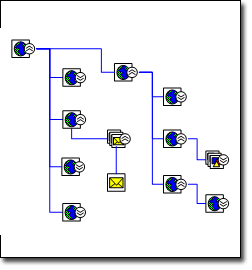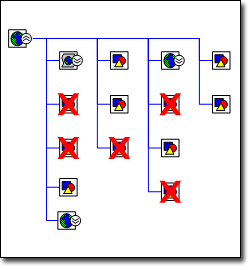If you manage a Web site's day-to-day operations, you know it's vital to have a clear picture of the site's overall structure and flow, track development changes, and monitor and repair broken hyperlinks. You can do all these tasks and more with the Web Site Map in Visio Professional or Visio Plan 2.

-
Start Visio.
-
In the Software and Database template/category, click Web Site Map.
-
Do one of the following:
-
If the Web site is on an HTTP server, in the Address box, enter the address of the Web site you want to map.
-
If the Web site is on a network server or a local hard drive, click Browse, navigate to the file you want at the root of your site map, and then click Open.
Note: For best results, enter a full path and file name. For example, enter http://www.contoso.com/default.asp rather than http://www.contoso.com.
-
-
Review the maximum number of levels and number of links that will be discovered.
-
To customize your Web site discovery, click Settings and do any of the following:
-
On the Layout tab, change the layout style of the Web site map, such as number of how many levels you want discovered or whether the drawing shows a Compact tree or a Flowchart.
-
On the Extensions tab, select the type of files (such as a .doc, .jpg, or .exe) that you want to map.
-
On the Protocols tab, select the protocols (such as mailto, ftp, or NNTP) that you want to map.
-
On the Attributes tab, select the HTML attributes (such as HREF, SRC, or CODE) that you want to search for links.
-
On the Advanced tab, select options that further refine your search criteria.
-
Click OK.
-
-
In the Generate Site Map dialog box, click OK.
A progress dialog box appears while the Web Site Map template generates the memory model and lays out your site map.
-
To realign or redistribute the links on the drawing page, on the Shape menu, click Lay Out Shapes.
Automatically check your site for errors
Keeping your site's links active and error-free is the most critical Web site management task.
When you map your site, Visio follows each link within the parameters you've specified and tracks any errors it encounters. The links with errors appear on the site map, in the Filter window, and in the List window as shapes with red Xs through them. The Filter and List windows are docked and collapsed on the left side of the drawing window.
Note: If you can't see these windows, click the Web Site Map tab on the ribbon, and select the check boxes next to List Window or Filter Window.
You can quickly generate a list of the broken links with their associated errors to help you keep track of your work and make the necessary repairs.

Create a report of links with errors on your site
-
Open the site map for which you want to create an error report.
-
On the ribbon, click the Web Site Map tab, and then click Create Report.
-
Select a report type that you want to run and then click Run.
-
Select what kind of file (such as Excel or XML) you want the information saved to, and then click OK.
Visio creates a report listing all the links that have hyperlink errors.
Note: If your report opens in a program outside of Visio, such as Excel, name and save the report.
Fix broken links
Some broken links are caused by timeout errors. To resolve those errors, right-click the link, and then click Refresh or Refresh Parent of Hyperlink.
Other broken links are caused by Site Not Found, Access Denied, or Password Required, or by incorrect file names, incorrect file locations, and missing files, which can trigger a 404 or File Not Found error message. Any of these will need to be fixed in your Web site.
Your Web site and the Web site map are not dynamically linked; changing one does not automatically affect the other. After you fix a broken link on the Web site, you can update the site map by right-clicking the shape representing the broken link, and then clicking Refresh Hyperlink. The red X disappears.
Keep track of changes to your site
If you have several developers working on your site, tracking their work can quickly become a full-time task. Using the Web Site Map comparison report, you can compare two versions of your site to quantify the changes made over a given period of time. The report compares the two versions and generates a list of differences. It not only identifies the links that appear in only one of the maps, but also lists the following link changes in both maps:
-
Error status
-
File title
-
File size
-
File modification date
For example, suppose you want to quantify the work done on the site each week. Simply map the site at the start of the week and again at the end. Then compare the two maps to generate a report of the changes. You can also measure the report against a schedule of work planned for the week to see if your Web site project is on target.
Compare Web site maps
-
Open the most recent map of your Web site.
-
On the Web Site Map tab, click Compare to document.
-
Browse to the Web site map you want to compare with, select the file, and then click Open.
Visio compares the two maps and generates an HTML report listing the differences.
-
Name and save the report.










